Scott Kenny
ACCESS: USAP
- Joined
- 15 May 2023
- Messages
- 11,202
- Reaction score
- 13,573
Granted, but about the same level of per-plane cost increase, 20-50%Or even less, 71 to 80...
Granted, but about the same level of per-plane cost increase, 20-50%Or even less, 71 to 80...
I would argue that the Sea Vixen was marginal in the FAD role before it was even introduced into service in 1959. With a top speed of 690 MPH, it was only 40 MPH faster than the TU-16s it was supposed to defend against. And by 1962, less than 3 years after the Sea Vixen entered service, the Soviets began fielding the KH-22 (AS-4 Kitchen) that had an operational range that was longer than the Sea Vixen's combat radius. Not to mention it could do Mach 4.6 on its way to the target.By the 70s the threats were increasing beyond the ability of Sea Vixen.
Second photo shows Firebrands not Fireflies so is no later than 1954 when that type left front line service.Nomisyrruc, what I meant to try to illustrate from the photo's was that the layout proposed by H_K in his earlier posts was that the tightly packed hangar was not how the Royal Navy stowed their aircraft. I attach two additional photo's (one is a repeat). The 1960's picture shows Buccaneers in the lower hangar (if I recall correctly the rear part of the lower hangar was used as workshop space following Eagle's modernisation), and the upper hanger shows Scimitars, Gannets right and left and Wessex helicopters down the centre. The stowage seems to allow for relatively easy movement of any type to the lifts, but it is quite 'snug' all the same. he other photo show's Eagles hanger in about 1956 (I'm guessing about the time of Suez), and shows three lines of aircraft (Firefly's I think), the smaller size of aircraft allowing for three-abreast stowage, though it's still quite 'snug'. It does still mean that aircraft can be moved to lifts. The main fact is that the aircraft are stowed in straight lines not crammed in at various angles.
Apologies- image downloaded from Internet and description was HMS Eagle at Suez.Second photo shows Firebrands not Fireflies so is no later than 1954 when that type left front line service.
And bubble canopies instead of two separated canopies in a ridgeback.Now, seeing that the aircraft have radial engines, the mis-timing is clear!
Here you go: a Centaur with 24x A-4 Skyhawks (!), 6x S-2E Tracker and 4x Sea Kings.I would love to see this draw (superb) but replacing the S-2 by A-4 and GAnnet x S-2E tracker.
That CV fit perfect on the forum "Alternative fighter for Argentine AF & Navy during Falklands war." for our Navy

Chapeau!!!! H.K.Here you go: a Centaur with 24x A-4 Skyhawks (!), 6x S-2E Tracker and 4x Sea Kings.
Probably more realistic for Australia than Argentina, but that’s another story.

I have long thought the RCN would have been better off with a Modified Centaur then Bonneventure.Here you go: a Centaur with 24x A-4 Skyhawks (!), 6x S-2E Tracker and 4x Sea Kings.
Probably more realistic for Australia than Argentina, but that’s another story.

Seeing as this is a more strike oriented air group, I would land the S-2s and put 4 E-1s on instead.I have long thought the RCN would have been better off with a Modified Centaur then Bonneventure.
She might have had a longer service life then Bonnie as well.
In theory, maybe. In practice though, you'd have to pick one or the other. For a small Navy/Country, they won't be able to afford two complete air groups for one carrier. The only Country in the world that can really afford to do have multiple types of air groups is the United StatesI suspect the E-1s would be mandatory. I know the RCN was discussing the purchase of the Tracer.
A Centaur might have allowed you to run either strike or ASW carrier wings.
What ? the Royal Canadian Navy ? they wanted E-1Bs ? that plane wouldn't fit on Bonaventure...the RCN was discussing the purchase of the Tracer.
If S-2 Trackers fit wouldn’t E-1 Tracers fit too? Same basic aircraft.What ? the Royal Canadian Navy ? they wanted E-1Bs ? that plane wouldn't fit on Bonaventure...
But I believe we’re talking about the E-1 Tracer, aren’t we? Not the E-2 Hawkeye.Not exactly. S-2 was much friendly weight and TWR. The E-2 was a pretty heavy machine for light carriers.
Yes, on all accounts I've seen , the E-1Bwas heavier - alas not by much. But when you factor in the size of the Majestic-class carriers dimensions and the mediocre catapult (along with the induced aerodynamic drag of the E-1's radome)....If S-2 Trackers fit wouldn’t E-1 Tracers fit too? Same basic aircraft.
Per the E-1B SAC sheet, at 26,594 pounds (MTOW), the power off stall speed of the Tracer is only 84 knots. And even a 103' BS4 could launch 40,000 pounds at 78 knots. So there's no reason Tracers couldn't have flown from BonnieYes, on all accounts I've seen , the E-1Bwas heavier - alas not by much. But when you factor in the size of the Majestic-class carriers dimensions and the mediocre catapult (along with the induced aerodynamic drag of the E-1's radome)....
S-2F
Maximum take off weight: 11,860 kg (26,147 lb)
E-1B
Maximum take off weight: 12,066 kg (26,600 lb)
So perhaps as a consequence, the Bonaventure would have had to be worked harder in terms of speed to achieve a greater wind over deck effect to get the E-1B airborne or it might have necessitated a reduced fuel load on take off (which wouldn't be good for it's on station patrol time)......
Regards
Pioneer
Thanks for that information SSgtC. I hadn't seen the fact sheet, until you alluded to them.Per the E-1B SAC sheet, at 26,594 pounds (MTOW), the power off stall speed of the Tracer is only 84 knots. And even a 103' BS4 could launch 40,000 pounds at 78 knots. So there's no reason Tracers couldn't have flown from Bonnie
The type had such a low stall speed that the USN would even launch them without using the cats. They'd just go old school with it, put the plane further down the deck, run up the engines, and let it take off under its own power while the carrier zipped along at 30 knots.Very interesting. I had thought about E-1B for Foch & Clemenceau (because CdG & E-2), but never quite realized it could have been flown from all the smaller carriers.
Naval AEW for everyone !
Oh gosh imagine if Argentina had AEW on 25 de mayo and the RN had none...
ArchibaldVery interesting. I had thought about E-1B for Foch & Clemenceau (because CdG & E-2), but never quite realized it could have been flown from all the smaller carriers.
Naval AEW for everyone !
Oh gosh imagine if Argentina had AEW on 25 de mayo and the RN had none...
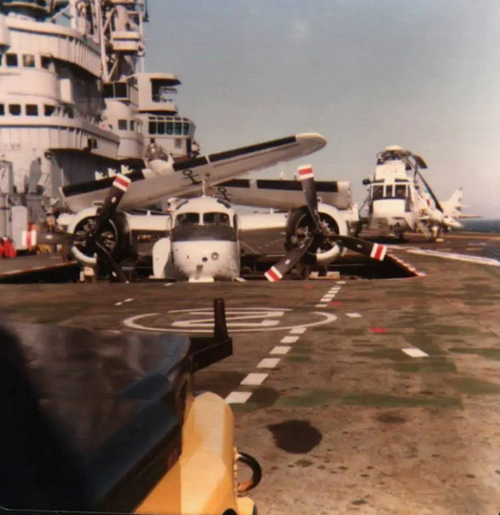
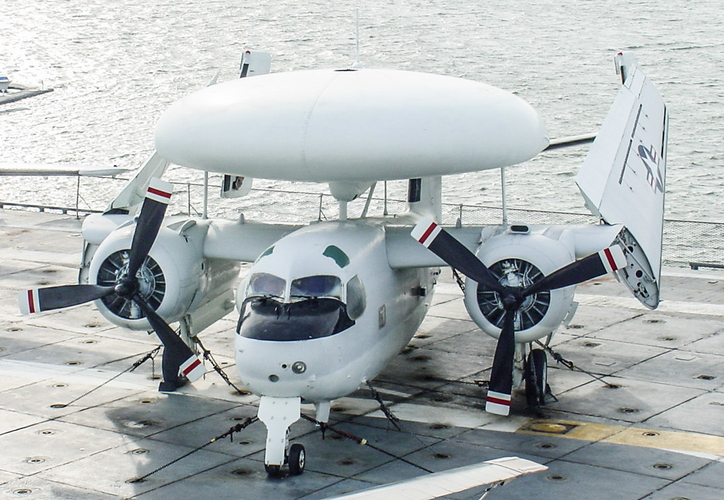
Yes, the E-1 was an airborne early warning and control aircraft. It was designed to control an air battle for a carrier air group.Archibald
Looking that photo
View attachment 727621
and this one
View attachment 727622
i dont think that the E-1 can fix inthe lift of the ARA 25 de Mayo.
So you he can only remain on deck.
I know the e-2 can detec AC, obviously, and plane too. if i not mistake?
Can do the E-1 do the same.?
If is yes, i must sid what and interesting mix (2 E-1 and 4 S-2E, 8 A-4Q, 6 SK and 2 alouette (SAR))
My mistake.Yes, the E-1 was an airborne early warning and control aircraft. It was designed to control an air battle for a carrier air group.
If you look at the E-1B specs I posted earlier, its wingspan is 30ft 5in. That should fit on the Colossus/Majestics’ 34ft wide elevators.i dont think that the E-1 can fix inthe lift of the ARA 25 de Mayo.
Ah, sorry. Yes, I believe that the APS-82 radar could detect surface targets. But I'm not 100% sure since there isn't much open source data on itMy mistake.
I said to time aircraft.
My question was. If i not mistake the E-2 can detec ship, too.
So the E-1 can do it, too?
Length is 45 ft 4 in (13.82 m), and height is 16' 10".If you look at the E-1B specs I posted earlier, its wingspan is 30ft 5in. That should fit on the Colossus/Majestics’ 34ft wide elevators.
Ahh that explains this photo then… those small lifts were a tight squeeze!While Venerable (Karel Doorman, 25 De Mayo) was also modernized in the same shipyard at about the same time (1955-58), she did not get lengthened lifts according to photos.

Thanks H_KIf you look at the E-1B specs I posted earlier, its wingspan is 30ft 5in. That should fit on the Colossus/Majestics’ 34ft wide elevators.
I think yes, lookin this 2 photos, but cant tell you, the specifical refits.Didn't the Argentine Navy rebuild her flight deck a couple of times over the years. I seem to recall through age dimmed memory , including during her last year or two in service.
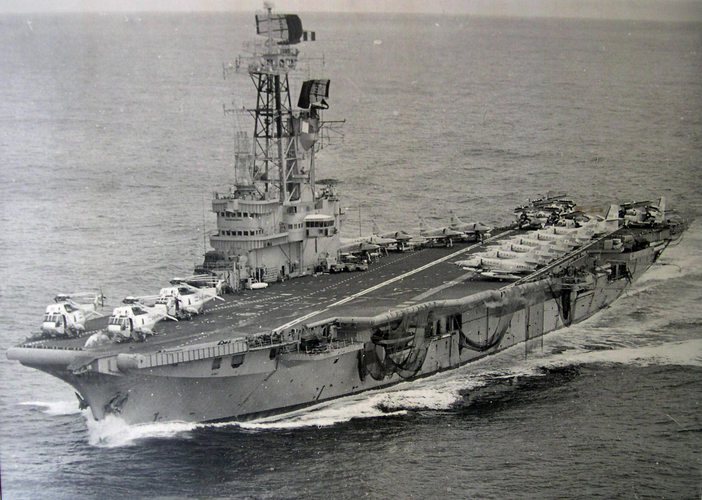
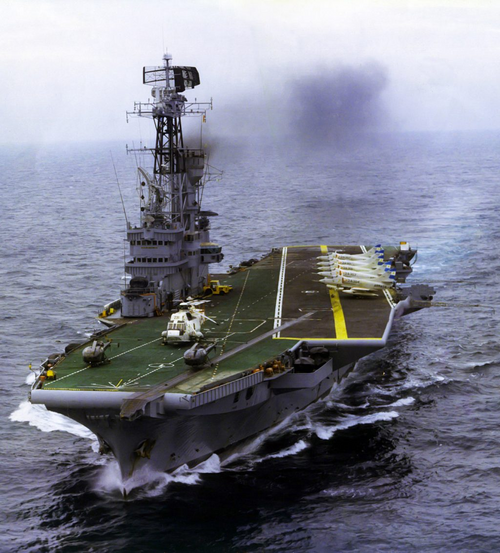
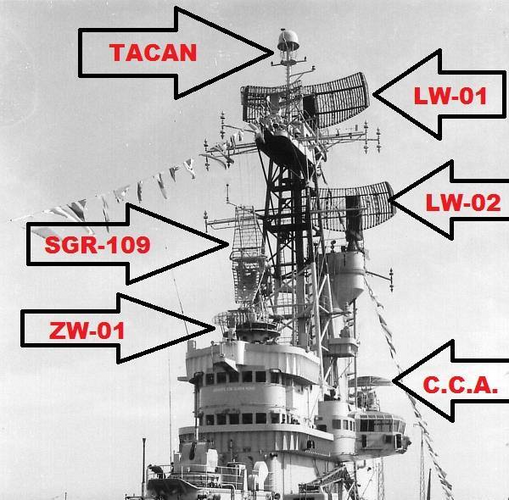
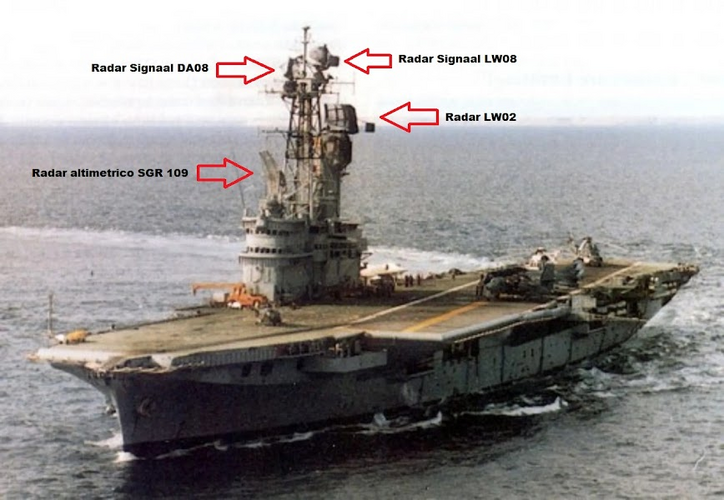
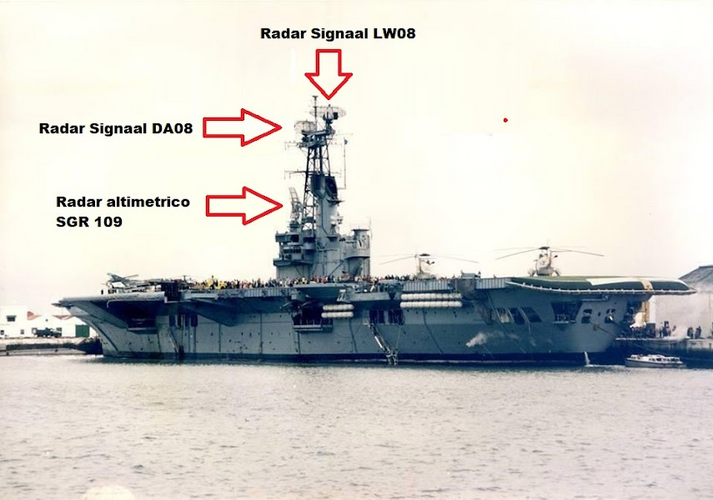
BlackBat242Length is 45 ft 4 in (13.82 m), and height is 16' 10".
S-2 Trackers were 42' 3" (early models) or 43' 6" (late models) and C-1 Traders were 42' 3" long.
Lifts on the Centaur/Hermes class were 44' x 54', so there would be no problem there.
The Colossus/Majestics' lifts were 45' long x 34' wide, so the only impediment was the length.
The hangars on all 3 classes had a clear height of 17' 6" (like the USN's Essex and Midway classes), so no height problem.
HMAS Melbourne, HMCS Bonaventure, and INS Vikrant received longer (54') lifts during their completion with steam catapults and the angle deck.
Vengeance (Minas Gerais), modified from mid-1957 to the end of 1960 in the Netherlands with a steam catapult and angle deck, also got longer lifts (drawings all show the 34' x 45' lift, but photographs show them with a greater length-width ratio).
While Venerable (Karel Doorman, 25 De Mayo) was also modernized in the same shipyard at about the same time (1955-58), she did not get lengthened lifts according to photos.
